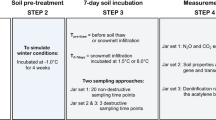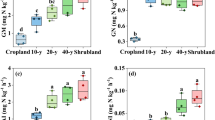Abstract
Inhibition by allelochemicals, including monoterpenes, has been suggested as a factor in the extremely low nitrification rates observed in coastal redwood forests. Similarities between the molecular structure of known nitrification inhibitors and some conifer monoterpenes have been suggested as one reason for the inhibition of autotrophic nitrifiers by conifer monoterpenes. The effect of monolerpenes on nitrification rate and growth of Nitrosomonas europaea was examined in whole-cell pure culture experiments using the five most abundant monoterpenes in coastal redwood needles. These are (in order of decreasing concentration in the needles) limonene, α-pinenc, sabinene, myrcene, and γ-terpinene. Four of the five compounds significantly inhibited growth of N. europaea in batch culture experiments. Short-term kinetic studies of the two most inhibitory monoterpenes, limonene and α-pinene, were performed on whole cells to evaluate the mode of interaction between these chemicals and nitrification rates. Inhibition constants (K i) of limonene (38 μM) and α-pinene (95 μM) were determined. Lineweaver-Burk plots of nitrification in the presence of monoterpenes appear to fit a noncompetitive inhibition model; however, the mechanisms of inhibition may be more complex.
Similar content being viewed by others
REFERENCES
BEDARD, C., and KNOWLES, R. 1989. Physiology, biochemistry and specific inhibitors of CH4, NH4 +, and CO oxidation by methanotrophs and nitrifiers. Microbiol. Rev. 53:68–84.
BERTSCH, W., and ANDERSON, E. 1975. Trace analysis of organic volatiles in water by gas chromatography-mass spectroscopy with glass capillary columns. J. Chromatogr. 112:701–718.
BREMNER, J. M., and MC CARTY, G. W. 1991. Effects of terpenoids on nitrification in soil—reply. Soil Sci. Soc. Am. J. 54:297–298.
BUTTON, D. K. 1984. Evidence for a terpene-based food chain in the Gulf of Alaska. Appl. Environ. Microbiol. 48:1004–1011.
FISCHER, N. H. 1991. Plant terpenoids as allelopathic agents, pp. 377–398, in J. B. Harbourne and F. A. Tomas-Barberan (eds.). Ecological Chemistry and Biochemistry in Plant Terpenoids. Oxford University Press, Oxford, UK.
FISCHER, H. Y., WILLIAMSON, C. B., WEIDENHAMER, J. D., and RICHARDSON, D. R. 1994. In search of allelopathy in the Florida scrub: The role of terpenoids. J. Chem. Ecol. 20:1355–1380.
GRASSHOFF, K., EHRHARDT, M., and KREMLING, K. (eds.). 1983. Methods of Seawater Analysis. Verlag Chemie, New York.
HALL, G. D., and LANGENHEIM, J. H. 1986a. Temporal changes in the leaf monoterpenes of Sequoia sempervirens. Biochem. Syst. Ecol. 14:61–69.
HALL, G. D., and LANGENHEIM, J. H. 1986b. Within tree spatial variation in the leaf monoterpenes of Sequoia sempervirens. Biochem. Syst. Ecol. 14:625–632.
HARDER, J., and PROBIAN, C. 1995. Microbial degradation of monoterpenes in the absence of molecular oxygen. Appl. Environ. Microbiol. 61:3804–3808.
HART, S. C., and FIRESTONE, M. K. 1991. Forest-floor mineral-soil interactions in the internal nitrogen cycle of an old-growth forest. Biogeochemistry 12:103–127.
HOOPER, A. B., and TERRY, K. R. 1973. Specific inhibitors of ammonia oxidation in Nitrosomonas. J. Bacteriol. 115:480–485.
HORNER, J. D., Gosz, J. R., and CATES, R. G. 1988. The role of carbon based plant secondary compounds in decomposition in terrestrial ecosystems. Am. Nat. 132:867–883.
HYMAN, M. R., and WOOD, P. M. 1983. Methane oxidation by Nitrosomonas europaea. Biochem. J. 212:31–37.
HYMAN, M. R., and WOOD, P. M. 1985. Suicidal inactivation and labeling of ammonia monooxygenase by acetylene. J. Biochem. 227:719–725.
HYMAN, M. R., SANSOME-SMITH, A. W., SHEARS, J. H., and WOOD, P. M. 1985. A kinetic study of benzene oxidation to phenol by whole cells of Nitrosomonas europaea and evidence for the further oxidation of phenol to hydroquinone. Arch. Microbiol. 143:302–306.
HYMAN, M. R., MURTON, I. B., and ARP, D. J. 1988. Interaction of ammonia monooxygenase from Nitrosomonas europaea with alkanes, alkenes, and alkynes. Appl. Environ. Microbiol. 54:3187–3190.
KEENER, W. K., and ARP, D. J. 1993. Kinetic studies of ammonia monooxygenase inhibition in Nitrosomonas europaea by hydrocarbons and halogenated hydrocarbons in an optimized wholecell assay. Appl. Environ. Microbiol. 59:2501–2510.
KILHAM, K. 1990. Nitrification in conifer forest soils. Plant Soil 128:31–44.
KNOBLOCH, K. H., WEIGAND, H., WEIS, N., SCHARM, H. M., and VIGENSHOW, H. 1986. Action of terpenoids on energy metabolism, pp. 429–445, in E. J. Burke (ed.). Progress in Essential Oil Research. Walter de Gruyter, Berlin.
LEES, H. 1946. Effect of copper enzyme poisons on soil nitrification. Nature 158:97.
LEES, H. 1952. The biochemistry of nitrifying organisms. I. The ammonia-oxidizing systems of Nitrosomonas. Biochem. J. 52:134–139.
LOHDI, M. A. K., and KILLINGBECK, K. T. 1980. Allelopathic inhibition of nitrification and nitrifying bacteria in a ponderosa pine (Pinus ponderosa Dougl.) community. Am. J. Bot. 67:1423–1429.
LERCH, K. 1981. Copper monooxygenase: Tyrosinase and dopamine beta-monooxygenase, pp. 143–186, in H. Sigel (ed.). Metal Ions in Biological Systems. Marcel Dekker, New York.
MC CARTY, G. W., and BREMNER, J. M. 1991. Inhibition of nitrification in soil by gaseous hydrocarbons. Biol. Fertil. Soil 11:231–233.
MULLER, C., and DEL MORAL, R. 1966. Soil toxicity induced by terpenes from Salvia leucophylla. Bull. Torrey Bot. Club 93:332–351.
PORTER, K. G., and FEIG, Y. S. 1980. The use of DAPI for identifying and counting aquatic microflora. Limnol. Oceanogr. 25:943–948.
OKOMOTO, R. A., ELLISON, B. O., and KEPNER, R. E. 1981. Volatile terpenes in Sequoia sempervirens. Changes in composition during maturation. J. Agric. Food Chem. 29:324–326.
RICE, E. L. 1984. Allelopathy, 2nd ed. Academic Press, New York.
SEGEL, I. H. 1976. Biochemical calculations: How to solve mathematical problems in general biochemistry. 2nd ed. John Wiley & Sons, New York.
SHEARS, J. H., and WOOD, P. M. 1985. Spectroscopic evidence for a photosensitive oxygenated state of ammonia monooxygenase. Biochem. J. 226:499–507.
SHUKLA, O. P., MOHOLAY, M. N., and BHATTACHARYYA, P. K. 1968. Microbial transformations of terpenes. Part X: Fermentation of α-and β-pinenes by a soil pseudomonad (PL strain). Indian J. Biochem. Biophys. 5:79–91.
SORIANO, R., and WALKER, N. 1968. Isolation of ammonia oxidizing autotrophic bacteria. J. Appl. Bacteriol. 31:493–497.
STRICKLAND, J. D. H., and PARSONS, T. R. 1972. A Practical Handbook of Seawater Analysis, 2nd ed. Bulletin 67. Fisheries Research Board of Canada.
SUZUKI, I., DULAR, U., and KWOK, S. C. 1974. Ammonia or ammonium as substrate for oxidation in Nitrosomonas europaea cells and extracts. J. Bacteriol. 120:556–558.
TANRISEVER, H., FISCHER, N. H., and WILLIAMSON, B. 1981. Menthofurans from Calamintha ashei: Effects on Sachyrium scoparium and Lactuca sativa. Phytochemistry 27:2523–2526.
URIBE, S., RAMIREZ, J., and PENA, A. 1985. Effects of beta-pinene on yeast membrane functions. J. Bacteriol. 161:1195–1200.
VANELLI, T., and HOOPER, A. B. 1992. Oxidation of nitrapyrin to 6-chloropicolinic acid by the ammonia-oxidizing bacterium Nitrosomonas europaea. Appl. Environ. Microbiol. 58:2321–2325.
WARD, B. B. 1987. Kinetic studies on ammonium and methane oxidation by Nitrosococcus oceanus. Arch. Microbiol. 147:126–133.
WARD, B. B. 1990. Kinetics of ammonia oxidation by a marine nitrifying bacterium: Methane as a substrate analogue. Microb. Ecol. 19:211–225.
WEIDENHAMER, J. D., MACIAS, F. A., FISCHER, N. H., and WILLIAMSON, G. B., 1993. Just how insoluble are monoterpenes? J. Chem. Ecol. 19:1799–1807.
WHITE, C. S. 1986. Volatile and water-soluble inhibitors of nitrogen mineralization in a ponderosa pine forest. Biol. Fertil. Soils 2:97–104.
WHITE, C. S. 1988. Nitrification inhibition by monoterpenoids: A theoretical mode of action based on molecular structure. Ecology 69:1631–1633.
WHITE, C. S. 1990. Comments on “The effects of terpenoids on nitrification in soil.” Soil Sci. Soc. Am. J. 54:296–297.
WHITE, C. S. 1991. The role of monoterpenes in soil nitrogen cycling processes in ponderosa pine. Biogeochemistry 12:43–68.
WHITE, C. S. 1994. Monoterpenes: Their effects on ecosystem nutrient cycling. J. Chem. Ecol. 20:1381–1406.
WILT, F. M., MILLER, A. G., EVERETT, R. L., and HACKETT, M. 1993. Monoterpene concentrations in fresh, senescent, and decaying foliage of single-leaf pinyon pine (Pinus monophylla Torr. & Frem: Pinaceae) from the western Great Basin. J. Chem. Ecol. 19:185–194.
WOOD, S. E. 1996. Loss of foliar monoterpenes from Umbellularia californica leaf litter and their influence on nitrification potential in soil beneath the trees. PhD dissertation. University of California, Santa Cruz, 151 pp.
WOOD, S. E., GASKIN, J. F., and LANGENHEIM, J. H. 1995. Loss of monoterpenes from Umbellularia californica leaf litter. Biochem. Syst. Ecol. 23:581–591.
Author information
Authors and Affiliations
Rights and permissions
About this article
Cite this article
Ward, B.B., Courtney, K.J. & Langenheim, J.H. Inhibition of Nitrosomonas europaea by Monoterpenes from Coastal Redwood (Sequoia sempervirens) in Whole-Cell Studies. J Chem Ecol 23, 2583–2598 (1997). https://doi.org/10.1023/B:JOEC.0000006668.48855.b7
Issue Date:
DOI: https://doi.org/10.1023/B:JOEC.0000006668.48855.b7




